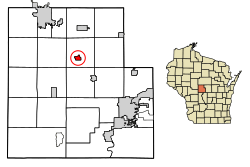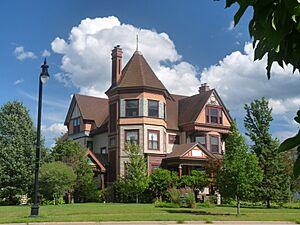Arpin, Wisconsin facts for kids
Quick facts for kids
Arpin, Wisconsin
|
|
|---|---|
|
Village
|
|

Location of Arpin in Wood County, Wisconsin
|
|
| Country | |
| State | |
| County | Wood |
| Area | |
| • Total | 0.82 sq mi (2.12 km2) |
| • Land | 0.82 sq mi (2.12 km2) |
| • Water | 0.00 sq mi (0.00 km2) |
| Elevation | 1,142 ft (348 m) |
| Population
(2020)
|
|
| • Total | 305 |
| • Estimate
(2023)
|
296 |
| • Density | 371.95/sq mi (143.87/km2) |
| Time zone | UTC-6 (Central (CST)) |
| • Summer (DST) | UTC-5 (CDT) |
| Zip code(s) |
54410
|
| Area codes | 715 & 534 |
| FIPS code | 55-03050 |
| GNIS feature ID | 1582718 |
Arpin is a small village in Wood County, Wisconsin, United States. In 2020, about 305 people lived there. It's a quiet place with a rich history, especially linked to the lumber industry and farming.
Contents
About Arpin's Location
Arpin is a small village. It covers an area of about 0.82 square miles (2.12 square kilometers). All of this area is land. There are no large lakes or rivers within the village limits.
A popular spot nearby is North Wood County Park. It's a great place for outdoor activities.
Arpin's History: From Lumber to Farms
Arpin started around 1890. It began when the John Arpin Lumber Company built a sawmill. This mill was located about a mile east of where the village is today.
The Arpin family, led by John Baptiste Arpin, were loggers. They had been working in Wisconsin since the 1860s. John's sons also joined the family business. Their operations were quite large. John Arpin's beautiful house, built in 1890, still stands in Wisconsin Rapids.
Near the first sawmill, a small community grew. It had a store, a post office, homes, a church, and a creamery. John's son, J. Z., became the first postmaster.
How the Village Moved
In 1890, a railroad line was built. It connected Wisconsin Rapids to Marshfield. This line was about a mile west of the first village. Another small village started along this new rail line. It had a store, a cheese factory, and homes.
However, the railroad built its main station (depot) in a different spot. This spot is where the current village of Arpin is located. Slowly, businesses and homes moved to be closer to the depot. This is how the village shifted to its present location.
More railroads were built over time. In 1891, the Wood County Railroad added a line to the mill. In 1902, the Chicago & Northwestern built another rail line. These lines helped transport lumber and goods.
A Mix of Cultures
Arpin was home to different groups of people. The Potawatomi and other Native American tribes lived nearby. They had a community at Skunk Hill. They sometimes invited outsiders to their dances.
Arpin also had a special settlement for Jewish families from Europe. A kind person named Baron Maurice de Hirsch wanted to help European Jews. Many were moving to big cities. He helped them settle in healthier places like Arpin.
As the trees were cut down, land and houses became available. A group bought 720 acres of land north of Arpin. Each family received about 40 acres. They also got livestock, tools, a home, and some money. The idea was to help them start new lives as farmers.
The first five families arrived on December 1, 1901. More families followed, many from Russia. By 1906, these new settlers had cleared land and started growing crops. They also cut wood to sell. In 1915, a Jewish place of worship was built. The community was strong, and they got along well with their Christian neighbors.
The Jewish settlement was never very large, with about 70 to 80 people. Most of them worked in farming. In the 1920s, people started to leave. The very cold winters and better jobs in nearby cities made farming difficult. This led to the slow decline of the settlement.
From Lumber to Dairy
By the 1920s, dairying became more important than lumbering. Four cheese factories were operating near Arpin. The Dairyman's State Bank opened in 1914. The village also had many other businesses. These included churches, a hardware store, a meat market, and a restaurant. There was even a hotel and a place for horses and taxis.
Who Lives in Arpin?
| Historical population | |||
|---|---|---|---|
| Census | Pop. | %± | |
| 1980 | 361 | — | |
| 1990 | 312 | −13.6% | |
| 2000 | 337 | 8.0% | |
| 2010 | 333 | −1.2% | |
| 2020 | 305 | −8.4% | |
| 2023 (est.) | 296 | −11.1% | |
| U.S. Decennial Census | |||
In 2010, there were 333 people living in Arpin. They lived in 143 households. The village had about 392 people per square mile.
Most people in Arpin were White (96.7%). A small number were Native American or Asian. Some people were of Hispanic or Latino background.
The average age of people in Arpin was about 38.8 years old. About 23.7% of residents were under 18. About 13.2% were 65 or older. The village had a nearly equal number of males (49.5%) and females (50.5%).
Famous People from Arpin
- Adolph Walter Rich, a businessman who helped many people.
- Byron Whittingham, who served as a representative for Wisconsin in the state government.
See also
 In Spanish: Arpin (Wisconsin) para niños
In Spanish: Arpin (Wisconsin) para niños


